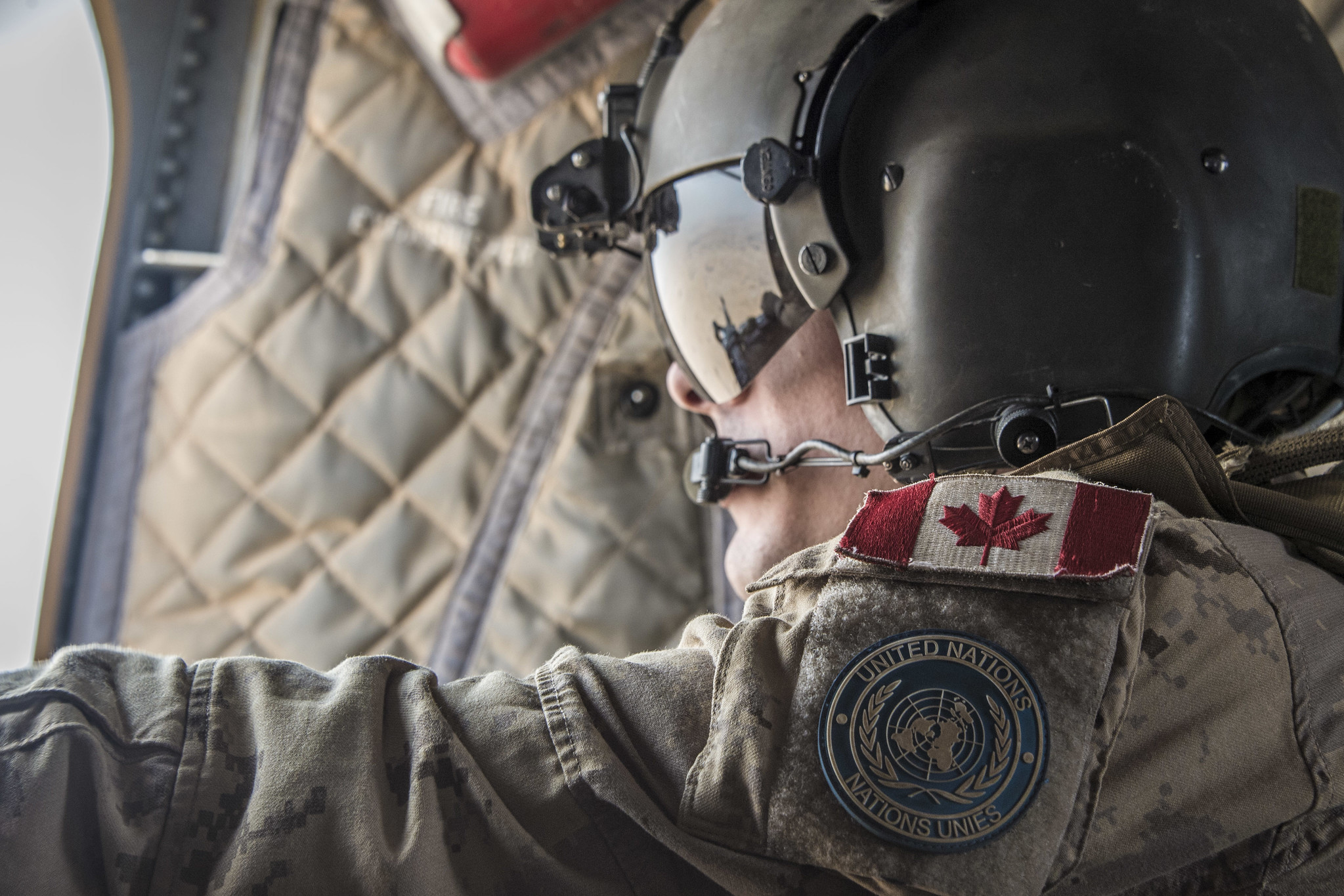
A door gunner keeps watch from a CH-147F Chinook helicopter as part of operation PRESENCE in Mali in May 2019. [Combat Camera/Corporal François Charest]
Of the 30 most fragile states in the world, 21 are in Africa, and many of those are French-speaking. It has been estimated that by 2050, 80 per cent of all French-speaking people will be African, due to high birth rates.
Instability will cause many countries to ask for the help of international forces to provide humanitarian aid, peacekeeping or policing. Canada’s bilingual military is an attractive candidate. About 46 per cent of regular force members are bilingual, including 73 per cent of regular force officers.
It has taken decades to get there, a result of a gradual change in attitudes rooted in British and French enmity over the colonization of North America. After the French defeat at Battle of the Plains of Abraham in 1759, French soldiers returned home and French-Canadian militias were disbanded. The British continued to defend Canada for more than a century, and their officers’ residual mistrust of the French military encompassed French-Canadians.
During the rebellions in 1837-38, Lieutenant-Colonel Baker of the Carleton militia wrote: “Bytown embraces six companies, of these at least three are composed of French-Canadians, and there is not a single French-Canadian officer, although several are well qualified.” A militia captain in another company refused to serve under a French-Canadian major.
There have always been bilingual soldiers in the Canadian military, but until after the Second World War, it was primarily one-way bilingualism, with French Canadians learning English so they could do their jobs and follow orders issued in their second language, points out French Canadians and Bilingualism in the Canadian Armed Forces by Jean Pariseau and Serge Bernier.
“In 1939, there were a scant 14 French-speaking units…all of them infantry battalions… The ‘bilingual’ brigades were made up of French- and English-speaking units side by side, mainly or entirely commanded, administered and trained in English…the main language of command and administration, French being used only for instruction and social activities,” they wrote.
In 1944, 19 per cent of all members of the services were French-speaking, including more than 4,000 army officers, 1,300 of them overseas. Three French-Canadians rose to the rank of brigadier-general, but they gave commands in English.

Regimental colours are presented to the Royal 22e Régiment on the Plains of Abraham in Quebec City in 1921.[Wikimedia/Bibliothèque et Archives nationales du Québec]
Emerging from the war, some critics believed French-Canadians had earned better opportunities, and others said the conscription crisis might have been avoided if the services had been more welcoming to francophones. French-Canadian regiments pressed to display their battle honours in French, and were turned down by the military, on the grounds that only the English version had royal approval. In 1956, Queen Elizabeth, colonel-in-chief of the Royal 22e Régiment and the Régiment de la Chaudière, gave her consent, which was extended to all French-Canadian regiments.
Brooke Claxton, the postwar defence minister, set his sights on 30 per cent French-Canadian representation in the services. “Both languages should be treated the same and both ethnic groups…given equal opportunities in the Canadian services,” he said in 1951.
In 1952, Lieutenant-General Guy Simonds replied: “We have gone as far as is practicable to go in meeting the desires of French-speaking Canadians.” The argument was that bilingualism would cost too much, but there was no doubt many senior officers wanted the armed forces to stay unilingual English.
There was gradual erosion of that attitude. In 1948, the army approved teaching French to English-speaking officers; the navy and air force demurred.
Real change began in 1958, when a study revealed that although equal proportions of English- and French-Canadians enlisted, only 14 per cent of commissioned officers and 21 per cent of non-commissioned officers were francophone, although 29 per cent of the Canadian population was French-Canadian.

To address retention, new French-speaking units were formed. French was used to issue commands at ceremonies. In 1961, French became the Royal 22e Régiment’s language of work.
The realization that bilingualism could be a military asset began to dawn in 1960, when Canada was asked to provide bilingual signallers for a United Nations mission to the Belgian Congo.
The pace of change accelerated in the 1960s thanks to several factors: appointment in 1966 of General Jean Victor Allard as chief of the defence staff; Quebec’s quiet revolution; Prime Minister Lester Pearson’s determination to ensure French and English were recognized as equals in Canada; the Bilingualism and Biculturalism Commission; and, finally, passing into law of the Official Languages Act on July 9, 1969, requiring all federal institutions to provide services in French or English on request.
On Feb. 20, 1970, a chief of the defence staff directive—published in both official languages—stated the forces’ goals: provide internal and external bilingual services, achieve proportional representation of French- and English-Canadians, allow military personnel to use either official language, and provide second-language instruction.
A bilingualism and biculturalism division was stood up to oversee roll-out. Today, the Directorate of Official Languages develops policies and support programs.
By 2003, bilingual personnel filled only 43 per cent of military postings deemed bilingual. Defence Minister John McCallum introduced language programs to address the shortage.
In 2016, on the occasion of the 40th anniversary of Royal Military College as the forces’ official language centre, Graham Fraser, commissioner of official languages, reminded cadets that during his tenure as chief of the defence staff, General Walt Natynczyk made it clear that the ability to speak in both official languages is necessary to rise to senior ranks.
But it is also important for Canadian unity, Fraser said. “You symbolize linguistic unity, and you must uphold this unity when you carry out your duties. Canada’s linguistic duality makes it a country of openness, discovery and respect for others. These are the values that you project when you become a leader in the Canadian Armed Forces.”
C’est vrai.
Advertisement



















